Wolfgang Amadeus Mozart
1756-1791
Biography
Born in Salzburg, Austria on Jan. 27, 1756; full name Johannes Chrysostomus
Wolfgangus Gottlieb Mozart; he was baptized as Johannes
Chrysostomus Wolfgangus Theophilus Mozart. Mozart is named after his
grandfather on his mother's side and after the Saint on his date of
birth, Johannes Chrysostomus.
Parents: Leopold Mozart - composer and violinist, concertmaster at the
archiepiscopal court, and in 1763, vice-kapellmeister at Salzburg court;
and Anna Maria Pertl, daughter of Wolfgang Nikolaus Pertl, an official
from Sankt Gilgen
Sibling: Maria Anna (Nannerl) Mozart
Age 3: started to play the keyboard
Age 5: started composing minuets
1763-1766 toured Europe with his father and sister played for Louis XV at
Versailles and George III in London
1764 wrote his first three symphonies; also met Johann Christian Bach
By his teenage years, he mastered the piano, violin, and harpsichord
1768 completed first opera, La finta semplice (The Simple Pretense)
1769-1773 made three trips to Italy
In Rome, there was a myth that Mozart attended the performance of
Allegri's Misere. He wanted the score but when no one agreed he
wrote down the music from memory.
1770 Mitridate, re di Ponte (Mithridates, King of Pontus) performed in Milan
was Mozart's first major opera
1772 appointed concertmaster in the orchestra of Archbishop of Salzburg.
During this period, he wrote many sacred works.
1777 toured with his mother hoping to find a court position; traveled to
Mannheim where he met and fell in love with Aloysia Weber
1778, July Anna Maria Mozart died
1779 unable to find a court position, Mozart went back to Salzburg; appointed
as court organist to the Archbishop of Salzburg
1781 resigned from his position due to increasing tension and disagreements
between Mozart and the Archbishop. Mozart stayed in Vienna instead
of returning to Salzburg. Mozart's resignation and his move to Vienna
put a strain in his relationship with his father.
1782 married Constanze Weber in Vienna's St. Stephen's Cathedral. After
Mozart's death, Constanze married Danish diplomat Georg Nikolaus
von Nissen. In Vienna, Mozart supported his family by performing in
public and private, teaching , and composing. His first opera written
after his residency in Vienna, Abduction from Seraglio became a
success.
1786 The Marriage of Figaro, the first of three operas Mozart collaborated with
librettist, Lorenza da Ponte, premiered at the Burg Theater.
1787 became composer of Imperial and Royal Chamber with an annual salary of
800fl. His father, Leopold, died on May 28, 1787. Don Giovanni
premiered in Prague at the National Theater.
1790 Cosi fan tutte premiered at Burg Theater. Mozart declined an
opportunity to compose in London.
1791 composed dance music for the Vienna Court; publishers began to pay
fees for the rights to publish his works; appointed assistant to the
Cathedral Kapellmeister at St. Stephens with no pay. Mozart was
already feeling ill in Prague while finishing La clemenza di Tito.
Dec. 5, 1791, a few minutes before 1AM, Mozart died of rheumatic fever.
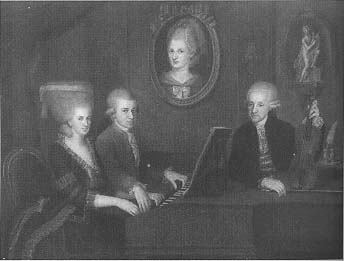
The Mozart family: Maria Anna, Mozart, painting of Anna Maria, and Leopold.
His Works
music in three stages: early 1761-1772
middle 1772-1781
late 1781-1791 best known works
Mozart composed over 600 works including:
21 stage and opera works, 15 Masses, over 50 symphonies, 25 piano
concertos, 12 violin concertos, 27 concert arias, 17 piano sonatas, 26
string quartets, and many other pieces.
His style was very unique, unlike many of the musical styles of his time.
People did not appreciate his radical music because they did not understand
Mozart's complex and extraordinary music. In his later years, Mozart
incorporates many musical elements and style from different countries into his
works. His late works include three of his most famous operas, The Marriage of
Figaro, Don Giovanni, Cosi fan tutte, written in collaboration with Lorenza da
Ponte and his last three church pieces, Mass in C Minor, Ave Verum Corpus, and
Requiem. Both the Mass in C Minor and Requiem remain unfinished.
Early Works:
La finta semplice (1768)
Bastien und Batienne (1768)
Mitridate, re di Ponto (1770)
Middle Works:
Missa in C, Coronation Mass (1779)
Late Works:
Idomeneo, re di Creta (1781)
The Abduction from Seraglio (1782)
Mass in C minor (1783)
The Marriage of Figaro (1786)
Don Giovanni (1787)
Cosi fan tutte (1790)
La Clemenza di Tito (1791)
The Magic Flute (1791)
Requiem (1791)
Mozart's Sacred Works
Masses and Kyries
K33 Kyrie in F (1766)
K90 Kyrie in d (1772)
K115 Missa brevis in C (incomplete)
K116 Missa brevis in F
K139 Missa solemnis in c ("Waisenhaus"-1768)
K167 Missa in C ("Holy Trinity"-1773)
K192 Missa brevis in F ("Little Credo"-1775)
K220 Missa brevis in C ("Sparrow"-1773-1777)
K257 Missa in C ("Credo"-1776-1777)
K258 Missa brevis in C ("Piccolomini"-1775)
K259 Missa brevis in C ("Organ solo"-1773-1777)
K262 Missa longa in C (1775)
K275 Missa brevis in B-flat (1773-1777)
K296a-c Mass (fragments-1777-1778)
K317 Missa in C ("Coronation"-1779)
K337 Missa solemnis in C (1780)
K341 Kyrie in d (1781)
K427 Mass in C (1783)
Litanies and Vespers
K109 Litaniae Lauretanae BVM (1771)
K125 Kitaniae de venerabili altaris sacramento in B-flat (1772)
K193 Dixit and Magnificat (1773-1777)
K243 Kitaniae de venerabili altaris sacramento (1773-1777)
K321 Vesperae de Dominica (1779)
K339 Vesperae de solennes de Confessore (1780)
Short Sacred Works
K34 Offertory ("Scande coeli limina")
K85 Miserere (1770)
K86 Antiphon ("Quaerite primum regnum Dei"-1770)
K108 "Regina coeli" in C (1771)
K127 "Regina coeli" in B-flat (1772)
K165 Motet, "Exsultate, jubilate" (1773)
K222 Offertory, Misericordias Domini (1773-1777)
K260 Offertory in D, "Venite, populi" (1773-1777)
K273 Sancta Maria in F (1773-1777)
K277 Offertory, "Alma Dei creatoris" (1773-1777)
K618 Motet, "Ave verum corpus" (1791)
Church Sonatas
K67 Church Sonata in E-flat (1772)
K68 Church Sonata in B-flat (1772)
K69 Church Sonata in D (1772)
K328 Church Sonata in C (1779)
K329 Church Sonata in C (1779)
K336 Church Sonata in C (1779)
Historical Setting of the Requiem
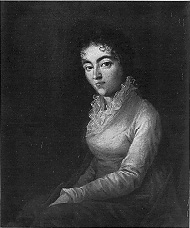
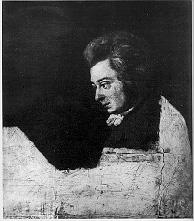
Mozart and Constanze
During the late 1790, Mozart had many financial problems contributed by the
following factors.
i. decline in popularity from 1788 in Vienna
ii. subscription concerts - from success in 1785 to only one subscriber
iii. no savings from his most successful years 1785-86
iv. steady increase in popularity in foreign countries. "His music was
now circulating via performances and publications throughout
Europe, especially in German-speaking regions and in France,
where his words were frequently listed on the programs of the
Concert Spirituel." (Maynard Solomon) However, there were no
performance rights or copyright laws. Composer paid only for
his service of physically playing or conducting what he
composed.
v. Constanze's numerous pregnancies and her health
vi. numerous expenses for appearances at court functions
vii. supported a household of six including his son, Karl Thomas, the
expected baby, Franz Xaver Wolfgang, and two servants.
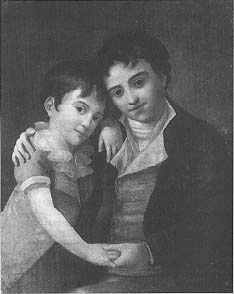
Karl and Franz Xaver Mozart: 1798-99.
However, during his last year, he slowly began to experience a reversal of
fortune.
i. gradually middle class society and Schikaneder theatre vs. court
opera and aristocratic salon
ii. relationship with his wife - loving, affectionate, and concerned
with Constanze's health
iii. an offer to go to London by British opera manager Robert May
O'Reilly
iv. May - became unpaid assistant to the cathedral kapellmeister at St.
Stephen's. If Mozart lived for more than two years, he would
have been the next kapellmeister with salary of 2000 fl.
v. late 1791, offers from Dutch and Hungarian nobility to compose a few
works
vi. fees were received by Mozart for the publication and manuscript
rights to some of his works
History of the Requiem (timeline)
Feb. 14, Herr Franz, Count von Walsegg's wife passed away at the age of 20.
mid July, messenger (Franz Anton Leitgeb, Count's steward) arrived with note
asking Mozart to write a Requiem Mass; fee and time; response by
messenger bring the advance fee
mid July, commission from Domenico Guardasoni, Impresario of the Prague National
Theater to compose the opera, La clemenza di Tito, for the festivities
surrounding the coronation on Sept. 6 of Leopold II as King of Bohemia
August, works mainly on La clemenza di Tito; complete by Sept. 5 in 18 days
Aug. 25, Mozart leaves for Prague; messenger reappears; in Prague already
started felling ill
Sept. 6, Mozart conducts premiere of La clemenza di Tito
mid Sept. to Sept. 28 revision and completion of The Magic Flute
Sept. 30, premiere of The Magic Flute
Oct. 7, completed Concerto in A for Clarinet
Oct. 8 - Nov. 20, worked on the Requiem and a Cantata
Nov. 20, confined to the bed due to his illness
Dec. 5, shortly after midnight Mozart died of acute rheumatic fever
Dec. 7, officially the 6th, buried in St. Marx Cemetery
Dec. 10, Requiem performed in St. Michael for a memorial for Mozart by Freihaus
theater
early Mar. 1792, probably the time Sussmayer finished the Requiem
evidence: Constanze signed a contract on Mar. 4, 1792, giving King
Frederick William II a copy of the Requiem
Jan. 2, 1793, performance of Requiem for Constanze's benefit arranged by
Gottfried van Swieten
early Dec. 1793, the Requiem was delivered to the Count
Dec. 14 1793, Requiem performed in the memory of his wife in the church at
Wiener-Neustadt
Feb. 14, 1794, Requiem performed again in the memory of his wife in Patronat
Church at Maria-Schutz on Semmering
1799, Breitkopf & Hartel published the Requiem
1825, Gottfried Weber wrote an article saying the Requiem was complete forgery
based on Sussmayer's 1801 letter to the newspaper
1825-present, debates about who contributed what
1833, Eybler died of a stroke while conducting a performance of Mozart's Requiem
Requiem's Commissioner
The Requiem was commissioned by Count Walsegg. The true and accurate details of
his request for a Requiem did not surface until 1964 when Otto Erich Deutsch
found the manuscript by Anton Herzog, who at the time of the commission was
under the services of the Count.
Herzog describes the Count as a very loving husband and as a man with great
interests in music.
"He was a passionate lover of music and the theatre; hence every week,
on Tuesdays and Thursdays, each time fully three hours' long, quartets
were played and on Sundays theatre, in which latter Herr Count himself,
and Madame Countess and her unmarried Madame Sister, took part, as did
all the officials and the entire, numerous household, all of whom had to
play roles, each according to his or her capacities."(Herzog Anton)
Since private concerts were held so often, the Count wanted many different
musical pieces to be performed during his Tuesday and Thursday sessions. The
Count obtained many of these works by commissioning well known composers.
After receiving the commissioned work he would recopy it in his own handwriting
never noting the true composer.
"The secretly organized scores he generally copied out in his own hand,
and presented them for the parts to be copied out. We never saw an
original score. The quartets were then played, and we had to guess who
the composer was. Usually we suggested it was the Count himself,
because from time to time he actually composed some small things; he
smiled and was pleased that we (as he thought) had been mystified; but
we were amused that he took us for such simpletons. We were all young,
and thought this an innocent pleasure which we gave our lord. And in
such fashion the mystifications continued among us for some
years."(Herzog Anton)
After Count Walsegg's wife died, he wanted to have two special memorials in her
honor. One was a sculpture. The other was the Requiem, which was to be played
annually on the anniversary of his wife's death. The Requiem was finally
performed in a memorial for the Count's wife on December 14, 1793.
Requiem Mass
text from the Requiem Mass in Latin
15 movements
A. Requiem 1. Requiem - chorus, soprano solo, chorus
B. Kyrie 2. Kyrie - choral
C. Sequence 3. Dies irae - choral
4. Tub mirum - bass, tenor, alto, soprano,
four soloists together
5. Rex tremendae - choral
6. Recordare - solo quartet
7. Confutatis
8. Lacrimosa - choral
D. Offertory 9. Domine Jesu - choral
10. Domine Hostias - choral
E. Sanctus 11. Sanctus - choral
F. Benedictus 12. Benedictus - solo quartet
G. Agnus Dei 13. Agnus Dei - choral
H. Communion 14. Lux aeterna - solo soprano, choral
15. Cum sanctis tuis - choral
four vocal parts: soprano, contralto, tenor, bass
-Mozart produces a new kind of sacred music where the focus is on the
vocal parts.
-"He deals with the four-part setting as a whole, he lets it unfold in
phrases and sections, he never singles out one voice over a longer
period."(Christoph Wolff)
instruments: 2 basset horns, 2 bassons, 2 trumpets, timpani, 3 trombones,
strings (included violins I and II, violas, cellos, and contrabasses),
and organ
total time: approximately 50 minutes
many different versions
1. Mozart & Sussmayer's version
2. Franz Beyer's version - editted the first version
According to Robin Golding, Beyer "cleansed the score of
Sussmayer's faulty harmonic realisations and his often
insensitive scoring."
3. Richard Maunder's version - Sanctus and Benedictus are omitted,
Lacrimosa from measure 9 to 30 is replaced by music from the
Requiem movement starting from the solo soprano part, and an
Amen fugue discovered a few decades ago is added after the
Lacrimosa.
Autograph draft scores
(in Mozart's handwriting) - all donated to Imperial
Library in Vienna
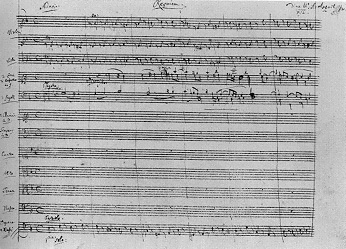
Autograph score of the Requiem:Kyrie.
early 1830's, Abbe Stadler - All five of the six movements for Sequence
except Lacrimosa
claims to have received it from 'Jemand' as a gift
1833. Joseph Eybler - Lacrimosa, Domine Jesu, Domine Hostias
claims to have received it from Georg Nikolaus Nissen
1838, Count Walsegg - 'original' full score of the complete Requiem
First two movements are Mozart's handwriting, while the rest is in
Sussmayer's handwriting, quite similar to Mozart's
received from Constanze

Autograph score of Requiem: Dies irae.
Compositional process
After Mozart's death, Constanze tried to find composers to finish the
Requiem. The order in which Constanze asked the composers are as follows:
1. Freystadtler (30 yrs old)
2. Eybler (26 yrs old) - Dec. 21, 1791 receives material from Constanze
3. Stadler (43 yrs old) - an old family friend, not a student
4. Sussmayer
Sussmayer's version the story
- Before Constanze gave the score to him, she had already asked several
other composers, but they all had other obligations or did not want to
work on the piece.
- Constanze finally gave it to Sussmayer because Mozart had discussed in
detail the finished movements, including the orchestration, with
Sussmayer. They had also played and sang what was completed before
Mozart's death.
- Mozart finished the four-part vocal score, the instrumental bass all
the way to the end of the Offertory, except Lacrimosa, which was only
finished through the eighth measure, and the motivic portions of
instrumentation.
- Sussmayer stated that he finished the Lacrimosa and composed Sanctus,
Benedictus, and Agnus Dei.
- For the last two movements, he used the music from the first two
movements.
After Sussmayer finished the piece, two copies were made. One was sent to
Breitkopf & Hartel, for publishing. The other copy remained in Constanze's
possession. The 'original' with only the first two movements in Mozart's
handwriting was sent to Count Walsegg.
Requeim Mass K.626 by Mozart
| | movements | composers who contributed
|
| Requiem | Requeim | composed by Mozart
|
| Kyrie | Kyrie | composed by Mozart ecxept the Colla-parte accompaniment, which was written by Franz Jacob Freystadler
|
| Sequence | Dies irae | Mozart finished the four part vocal score, the instrumental bass, and the motivic portions of the instrumentation | Joseph Eybler wrote the instrumentation; later Sussmayer copies Eybler's instrumentation with some minor revisions
|
| | Tub mirum | sam as above | same as above
|
| | Rex tremendae | same as above | same as above
|
| | Recordare | same as above | same as above
|
| | Confutatis | same as above | same as above
|
| | Lacrimosa | Mozart finished only through the eighth measure | Joseph Eybler write the instrumentation for mm. 9-10; Sussmayer wrote the instrumentation for mm.1-8 and composed mm. 9-30
|
| Offertory | Domine Jesu | Mozart finished the four-part vocal score, the instrumental bass, and the motivic portions of the instrumentation | Abbe Stadler might have worked on the instrumentation; Sussmayer wrote the instrumentation or used Stadler's with some revisions
|
| | Domine Hostias | same as above | same as above
|
| Sanctus | Sanctus | | Sussmayer's composition
|
| Benedictus | Benedictus | | Sussmayer's composition
|
| Agnus Dei | Agnus Dei | | Sussmayer's composition, but here he may have used some of Mozart's drafts**
|
| Communion | Lux aeterna | Requiem composition measures 23-52 by Mozart are reused; adjusted slightly for the different text |
|
| | Cum sanctis tuis | Kyrie composition mm. 1-52 by Mozart is reused; adjusted slightly for the different text |
|
| **There has been many criticisms of Sussmayer's contributions. The main criticism is focused on Sanctus and Benedictus. However, with Agnus Dei, Wolff believes that it "juxtaposes a highly balanced and, in terms of rhetorical intensity, extremely effective four-part vocal setting and a complementary instrumental motif, exactly according to the manner of, for instance, the 'Domine Jesu'." Many speculate that Constanze gave Sussmayer drafts that Mozart had been working on. Some of these may have contained instructions or preliminary vocal ideas for not only Agnus Dei but also Sanctus and Benedictus. (these drafts were mentioned by Constanze in a letter to Stadler in 1827.)
|
Requiem Mass in D minor (K. 626) Text
Requiem
Requiem aeternam dona eis, Domine, Grant them eternal rest, O Lord,
et lux perpetua luceat eis. and may perpetual light shine on them.
Te decet hymnus, Deus, in Sion, Thou, O God, art praised in Sion,
et tibi reddetur votum in Jerusalem. and unto Thee shall the vow
Exaudi orationem meam, be performed in Jerusalem.
ad te omnis caro veniet. Hear my prayer, unto Thee shall all
Requiem aeternam dona eis, Dimine, flesh come.
et lux perpetua luceat eis. Grant them eternal rest, O Lord,
and may perpetual light shine on them.
Kyrie
Kyrie eleison. Lord have mercy upon us.
Christe eleison. Christ have mercy upon us.
Kyrie eleison. Lord have mercy upon us.
Sequentia
Dies irae, dies illa Day of wrath, that day
Solvet saeclum in favilla, Will dissolve the earth in ashes
Teste David cum Sibylla. As David and the Sibyl bear witness.
Quantus tremor est futurus What dread there will
Quando judex est venturus When the Judge shall come
Cuncta stricte discussurus. To judge all things strictly.
Tuba mirum spargens sonum A trumpet, spreading a wondrous sound
Per sepulcra regionum Through the graves of all lands,
Coget omnes ante thronum. Will drive mankind before the throne.
Mors stupebit et natura Death and Nature shall be astonished
Cum resurget creatura When all creation rises again
Judicanti responsura. To answer to the Judge.
Liber scriptus proferetur A book, written in, will be brought
In quo totum continetur, forth
Unde mundus judicetur. In which is contained everything that is
Out of which the world shall be judged.
Judex ergo cum sedebit When therefore the Judge takes His seat
Quidquid latet apparebit, Whatever is hidden will reveal itself.
Nil inultum remanebit. Nothing will remain unavenged.
Quid sum miser tunc dicturus, What then shall I say, wretch that I am
Quem patronum rogaturus, What advocate entreat to speak for me,
Cum vix justus sit securus? When even the righteous may hardly be
secure?
Rex tremendae majestatis, King of awful majesty,
Qui salvandos salvas gratis, Who freely savest the redeemed,
Salve me, fons pietatis. Save me, O fount of goodness.
Recordare, Jesu pie, Remember, blessed Jesus,
Quod sum causa tuae viae, That I am the cause of Thy pilgrimage,
Ne me perdas illa die. Do not forsake me on that day.
Quaerens me sedisti lassus, Seeking me Thou didst sit down weary,
Redemisti crucem passus, Thou didst redeem me, suffering death
Tantus labor non sit cassus on the cross.
Let not such toil be in vain.
Juste judex ultionis Just the avenging judge,
Donum fac remissionis Grant remission
Ante diem rationis. Before the day of reckoning.
Ingemisco tamquam reus, I groan like a guilty man.
Culpa rubet vultus meus, Guilt reddens my face.
Supplicanti parce, Deus. Spare a suppliant, O God.
Qui Mariam absolvisti Thou who didst absolve Mary Magdalene
Et latronem exaudisti, And didst hearken to the thief,
Mihi quoque spem dedisti. To me also hast Thou given hope.
Preces meae non sunt dignae, My prayers are not worthy,
Sed tu bonus fac benigne, But Thou I Thy merciful goodness grant
Ne perenni cremer igne. That I burn not in everlasting fire.
Inter oves locum praesta, Place me among Thy sheep
Et ab haedis me sequestra, And seperate me from the goats,
Statuens in parte dextra. Setting me on Thy right hand.
Confutatis maledictis When the accursed have been confounded
Flammis acribus addictis, And given over to the bitter flames,
Voca me cum benedictis. Call me with the blessed.
Oro supplex et acclinis, I pray in supplication on my knees.
Cor contritum quasi cinis, My heart contrite as the dust,
Gere curam mei finis. Safeguard my fate.
Lacrimosa dies illa Mournful that day
Qua resurget ex favilla When from the dust shall rise
Judicandus homo reus. Guilty man to be judged.
Huic ergo parce, Deus, Therefore spare him, O God.
Pie Jesu Domine, Merciful Jesus, Lord
Dona eis requiem. Grant them rest.
Offertorium
Domine, Jesu Christe, Rex gloriae, Lord Jesus Christ, King of glory,
libera animas omnium fidelium deliver the souls of all the faithful
defunctorum departed from the pains of hell and
de poenis inferni, et de profundo lacu: from the bottomless pit.
libera eas de ore leonis, Deliver them from the lion's mouth.
ne absorbeat eas tartarus, ne cadant Neither let them fall into darkness
in obscurum, nor the black abyss swallow them up.
sed signifer sanctus Michael And let St. Michael, Thy standard-
retraesentet eas in lucem sanctam, bearer, lead them into the holy light
quam olim Abrahae promisisti which once Thou didst promise
et semini ejus. to Abraham and his seed.
Hostias et preces, tibi, Domine, We offer unto Thee this sacrifice
laudis offerimus; of prayer and praise.
tu suscipe pro animabus illis, Receive it for those souls
quarum hodie memoriam facimus: whom today we commemorate.
fac eas, Domine, de morte transire ad Allow them, O Lord, to cross
vitam, from death into the life
quam olim Abrahae promisisti which once Thou didst promise to
et semini ejus. Abraham and his seed.
Sanctus
Sanctus, Sanctus, Sanctus, Holy, holy, holy,
Dominus Deus Sabaoth! Lord God of Sabaoth
Pleni sunt coeli et terra gloria tua. Heaven and earth are full of Thy glory.
Osanna in excelsis. Hosanna in the highest.
Benedictus
Benedictus qui venit in nomine Domini. Blessed is He who cometh in the name of
Osanna in excelsis. the Lord. Hosanna in the highest.
Agnus Dei
Agnus Dei, qui tollis peccata mundi, Lamb of God, who takest away the sins of
dona eis requiem. the world, grant them rest.
Agnus Dei, qui tollis peccata mundi, Lamb of God, who takest away the sins of
dona eis requiem sempiternam. the world, grant them everlasting rest.
Communion
Lux aeterna luceat eis, Domine, May eternal light shine on them, O Lord
cum sanctis tuis in aeternum, with Thy saints for ever,
quia pius es. because Thou art merciful.
Requiem aeternam dona eis, Domine, Grant the dead eternal rest, O Lord,
et lux perpetua luceat eis, and may perpetual light shine on them.
cum santis tuis in aeternum, with Thy saints for ever,
quia pius es. because Thou are merciful.
Early Biographers
Much of what is known today about Mozart comes either directly from
correspondences about him, to him, and from him, or indirectly from biographers
who gathered information from interviews with people close to him, such as his
wife, Constanze, his works, and material from people who have come in contact
with Mozart. The following is a brief summary of the early biographers who have
tried to tell the story of Mozart's life.
1. Friedrich Schlichtegroll was a teacher and a scholar. Published Mozart's
obituary in 1793. This obituary was part of a volume of obituaries referred to
as Nekrolog. The two had never met. Most of the information was obtained from
Nannerl, Mozart's sister, and Johann Andreas Schachtner, a friend of the family
in Mozart's early years. Therefore what Schlichtegroll knew and wrote about was
the period before Vienna.
2. Franz Xaver Niemetschek was a citizen of Prague, a teacher and writer.
Unlike Schlichtegroll, Niemetschek did neet with Mozart and was acquainted with
Mozart's friends in Prague. After the death of Mozart, Constanze sent Carl, the
elder son, to live with him from 1792-97. Through these relationships with the
family, Niemetschek gathered the information needed to write a biography of
Mozart. His main source was Constanze and Mozart's friends in Prague.
Therefore his emphasis was on Mozart's years in Vienna and his many trips to
Prague.
3. Friedrich Rochlitz was the editor of Allgemeine Musikalische Zeitwig (AMZ), a
journal, which was published by Breitkopf & Hartel. Constanze had sent Rochlitz
some ancedotes to publish. At first she wanted him to do a biography but after
meeting Nissen, she gave Nissen the opportunity instead. Most people believed
that Rochlitz is an unreliable source.
4. ITFC Arnold, a novelist, wrote Mozarts Geist, published in 1803. He
takes most of the biography directly from the three sources already published.
He does add in some new information.
5. In 1828, Nissen published a biography of Mozart which included an appendix
written by Constanze and J.H. Fewerstein after Nissen's death in 1826. Much of
this biography included what had been previously written by Schlichtegroll,
Niemetschek, and Rochlitz. In The Mozart's Myths, Stafford writes:
"Sometimes Nissen corrects the chunks he borrows, and occasionally he tells the
reader that he has done this...unfortunately, he does not always correct and
revise in this way. Assembling his narrative with scissors and paste, he allows
contradictions to creep in." Nissen, knowing that it was untrue, wrote that
the unfinished Requiem was taken by the messenger immediately after Mozart's
death.
6. Vincent and Mary Novello's diary of their interviews during 1829 with
Nannerl, Constanze, and Mozart's sister in law, was discovered and published in
1955. They were collecting this information in hopes of publishing a book,
which never happened. Since almost forty years had gone by since Mozart's
death, then these accounts might have been based more on already published
biographies than on the participants' own memories.
Mass in C Minor
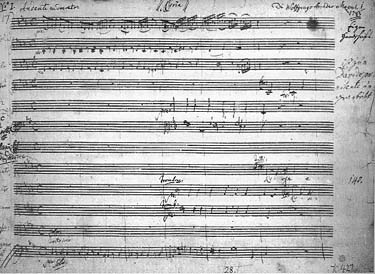
Autograph score of the Mass in C Minor: Kyrie.
The Mass in C minor was not a commissioned work. Since most of Mozart's work
was written for money or for advancement in positions, then one wonders why he
worked on this particular piece.
"For example, the clavier music was written mainly for performance or
for teaching purposes; the operas were written in response to specific
commissions or occasionally in the hope of a production; the
symphonies, for a variety of uses, including, in later years, as
showpieces of his capabilities; the orchestral dances, to fulfill his
obligations as imperial chamber composer and to earn publication fees;
the Salzburg church music, in connection with his responsibilities to
the court; the Requiem, to Count Walsegg's order; and the wind
instrument concertos, for specific virtuoso players."(Maynard Solomon)
He probably composed this piece to express his love for his wife as well as to
reconcile with his family, Leopold and Nannerl.
As Maynard Solomon writes,"It is a peace offering, which aims to
demonstrate Mozart's piety and to heal the family rift, thus to achieve
reconciliation with his fater and sister. At the same time it is a
token of his marriage to Constanze, his gift of love to her, the
expression of his gratitude to God for having granted him this sacred
union and blessed it with a child. It is written to glorify Constanze;
it is her Magnificat."
The composition of the Mass was exactly the opposite of the type of Mass the
Archbishop of Salzburg directed. In June 1780, the Archbishop wrote that he
wanted to eliminate complex forms of church music. In addition, after his
reforms, the Salzburg style became limited to no longer than 45 minutes and no
solo singing or fugue was permitted. This Mass was quite different then the
Salzburg style. Not only did the Mass use baroque, classical, Salzburg,
Viennese, and Italian music, but it was also longer than 45 minutes. He started
composing the Mass during late 1782. It premiered in October 26, 1783 in St.
Peter's Church. Constanze sang a solo part. Since the piece was not completed
yet, Mozart used sections from his earlier masses to supplement the missing
parts. The Mass includes Kyrie, Gloria, Credo (completed only to Et
incarnatus), and incomplete drafts of Sanctus and Benedictus. The four solo
vocal parts are soprano I, soprano II, tenor, and bass. The instruments
include: 2 bassoons, flute, 2 horns, 2 oboes, timpani, 2 trumpets, 3 trombones,
strings, and organ. Even though this work was never finished, parts of the
music were used later on in Mozart's Davidde penitente, a cantata.
Bibliography
Landon, H.C. Robbins. Mozart's 1791 Last Year
Solomon, Maynard. Mozart: A Life.
Stafford, William. The Mozart Myths.
Wolff, Christoph. Composition and Completion of the Requiem.
Mozart Web Page Sites
1. http://www.vivanet.com/~sboerner
Titled The Mozart Project. This is a great place to find all types of
information on Mozart. From this page you can access What's New about the
Mozart Project and an entire chronology of Mozart's life. There are also notes
and reviews of books that deal with Mozart.
1a. http://www.vivanet.com/~sboerner/comp.k_626_htm
Requiem in D minor
1b. http://www.vivanet.com/~sboerner/comp.k_368a_htm
What's New
2. http://www.spb.su//lifestyl/138/requiem.html
Titled Mozart's Requiem by Karl P Henning
3. http://pathfinder.com/@@p*6ccuMyyAlAQE25/time/magazine/domestic/ 1995/950:
Titled Myth of the Divine Child by Michael Walsh
A review of Maynard Solomon's book, Mozart.
4. http://www.roughguides.com/RG_WWW/C_music/cla_Moz.html
The Rough Guide to Classical Music Wolfgang Amadeus Mozart
4a. http://www.roughguides.com/RG_WWW/C_music/Moz_sac.html
Sacred Music
5. http://www.mhrcc.org/mozart/mozart.html
Index to most Mozart sites on the Web
Biographies:
6. http://plaza.interport.net/nyopera/education/mozart.html
New York City Opera Biography of Wolfgang Amadeus Mozart
7. http://classicalmus.com/composers/mozart.html
Classics World Biography of Wolfgang Amadeus Mozart
8. http://www.ida.his.se/ida/~a94johal/mozart.html
Wolfgang Amadeus Mozart by Johan Alkerstedt
9. http://www.demon.co.uk/creative/fairfield/mozart.html
Wolfgang Amadeus Mozart by Creative Pitch
10. http://www.hk.super.net/~naxos/mozart_w.htm
First it has a brief biography of Mozart. Then it goes into the following
subtopics with recommended recordings: operas, church music, vocal and choral
music, orchestral music, cassations, divertimenti, serenades, dance music,
concertos, chamber music, piano music, and organ music.
11. http://www.glasscity.net/~omoral/mozart.html
Mozart: A tribute to Wolfgang Amadeus Mozart. Contains Biography,
Compositions, Musical Samples, and Recordings.
11a. http://www.glasscity.net/~omoral/biography.html
Mozart's Biography
12. http://weber.u.washington.edu/~sbode/music/german1.html
Wolfgang Amadeus Mozart by Grolier Electronic Publishing, Inc.
13. http://www.edinboro.edu/CWIS/Music/Cordell/comp-Mozart.html
Requiem Text:
14. http://copper.ucs.indiana,edu/~lneff/libretti.mreqlat.txt
Requiem text in Latin
15. http://emerald.yonsei.ac.kr/~nyang/requiem
Requiem Mass text in various languages






